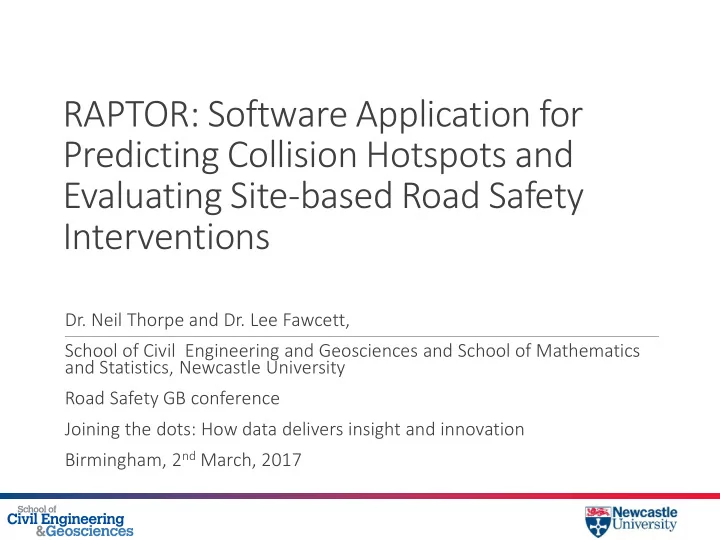

RAPTOR: Software Application for Predicting Collision Hotspots and Evaluating Site-based Road Safety Interventions Dr. Neil Thorpe and Dr. Lee Fawcett, School of Civil Engineering and Geosciences and School of Mathematics and Statistics, Newcastle University Road Safety GB conference Joining the dots: How data delivers insight and innovation Birmingham, 2 nd March, 2017
Background 2003: Northumbria Safety Camera Partnership ◦ Site selection, data reporting to DfT, site evaluation 2006/08: Health impacts study of mobile safety cameras ◦ Focus on actual scheme effects after confounding effects of RTM and trend ◦ Algorithms for evaluating interventions 2010: Focus on ‘research impact’ 2012: Industrial collaboration with PTV Group ◦ Development of hotspot prediction algorithms 2015: Implementation in software applications 2017: Software now accessible to practitioners
…but prone to confounding factors of regression-to- mean and general accident trends
Observed counts at individual sites are due to…. Total observed frequency (100%) Prevailing RTM SAFETY level of site safety Confounding factors TREND Variation over time and between sites
Problems for evaluation and prediction (site selection) Blip? Collisions per year Negative Blip? trend? Time
Problems for evaluation How much of any observed change is due to: - Our scheme? - RTM? - Trend? Collisions per year Before After Time
Problems for prediction (site selection) ? ? Collisions per year ? Time
Accounting for RTM and Trend RTM ◦ Ignore it – assume it don’t exist ◦ Four Time Period (FTP) method ◦ Bayesian techniques (Empirical or Full) Trend ◦ Ignore it ◦ Network-wide and site-specific trends ◦ Recent observations versus observations further back in time
Why are confounding factors a problem? Cause ‘noise’ in the collision count data For hotspot identification: ◦ False positives: identifying and treating sites as hotspots when they are not – collision rate would have reduced anyway; an issue of ‘wasted’ resources ◦ False negatives: not treating a genuinely unsafe site; impact for future collision rates For scheme evaluation: ◦ Believing that our schemes are being more effective than they actually are – value for money issues and ‘misguided’ future decisions
Key features of RAPTOR Package Three key functions: ◦ Hotspot prediction ◦ Scheme evaluation ◦ (Contributory factors analysis) RTM ◦ …. ◦ ….. Trend ◦ Variance inflation (more weight on more recent observations) ◦ Weighted combination of network and site-specific trends
How good are the hotspot predictions? 11
RAPTOR Demonstration Data requirements ◦ Hotspot prediction and scheme evaluation ◦ De Dependent varia ariable: Collision/casualty counts in discrete time periods (e.g. months, quarters or years) for each site ◦ Ind ndependent var ariables: Static site data (e.g. speed limit; road type; road class, urban/rural); dynamic site data (e.g. flow; average speeds) for each time period for each time period
Screenshots If needed…..
Current and Future Demonstrations/Applications • Northumbria (NSRI); Suffolk (cyclist collisions); North Yorkshire County Council and North Yorkshire Police • Halle, Germany; National Technical University of Athens, Greece • Florida Department of Transport (seasonal effects); Texas A & M University • China and S Korea (via Monash University); Guyana Ministry of Public Infrastructure • World Resources Institute (US, Mexico, Turkey, India, Brazil, China…) • Abu Dhabi Police; University of Dammam, Saudi Arabia; • Training courses in Rio, Brazil in 2015 and Bolivia, 2016 with WRI/PTV Group • On-line demo (login required) • Software tool
References Early Example of Scheme Evaluation Thorpe N, Fawcett L. (2012) ‘Linking road casualty and clinical data to assess the effectiveness of mobile safety enforcement cameras: a before and after study.’ BMJ Open, 2(6), e001304. http://bmjopen.bmj.com/content/2/6/e001304?ct Statistical Methodology Fawcett, L.; Thorpe, N. (2013) Mobile safety cameras: estimating casualty reductions and the demand for secondary healthcare. Journal of Applied Statistics 40(11), 2385-2406 http://www.tandfonline.com/doi/full/10.1080/02664763.2013.817547 Fawcett, L.; Thorpe, N.; Matthews, J.; Kramer, K. (2017) A novel Bayesian hierarchical model for road safety hotspot prediction. Accident Analysis & Prevention, 99, pp.262-271. http://www.sciencedirect.com/science/article/pii/S0001457516304341 Papers Aimed at Road Safety Practitioners Slater, P.; Thorpe, N.; Fawcett, L. (2014) Getting Value for Money from Investment in Road Safety: Are we Evaluating our Schemes Correctly? Paper presented at the 12th Annual Transport Practitioners’ Meeting, Session: Road Safety – the Future, London, 2014 (July) Fawcett, L.; Matthews, J.; Kremer, K.; Thorpe, N.; Galatioto, F.; Hoffman, T.; Muench, A. (2015) Identifying Collision Hotspots using Time Series Analysis and Accounting for Regression to Mean Paper presented at the 13th Annual Transport Practitioners’ Meeting, Session: Road Safety: Design Applications, London, 2015 (July )
References Oral Presentations and Posters to Road Safety Academics, Practitioners and Policy Makers Thorpe , N.; Fawcett , L.; Matthews , J.; Newman , K.; Kremer , K; Ahuja , S. (2015) A software application for identifying future collision hotspots and evaluating road safety interventions while accounting for regression to mean and trend. 24 th World Congress of the International Traffic Medicine Association, 16 th -18 th November, 2015, Doha, Qatar Thorpe, N. (2014) Identifying Collision Hotspots and Evaluating Road Safety Schemes: Issues for Investment Decisions. Embarq International Road Safety Research and Training Workshop, 6 th -10 th October, Rio de Janeiro, Brazil Thorpe, N. (2016) Issues with Interpreting Collision Data: How to Manage Confounding Factors when Identifying Collision Hotspots and Evaluating Road Safety Interventions WRI/PTV/Newcastle University International Road safety Research and Training Workshop, 28/11/16-2/12/16, Santa Cruz, Bolivia Fawcett, L.; Matthews, J.; Kremer, K.; Thorpe, N.; Galatioto, F.; Muench, Road Safety Hotspot Prediction: A Study of the City of Halle, Germany. Poster presentation at the 95 th Annual Meeting of the Transportation Research Board, January 2016, Washington DC. Fawcett, l.; Matthews, J; Kramer, K.; Thorpe, N. (2017) Road Safety Hotspot Prediction: Study of Halle, Germany. Poster presentation at the 96th Annual Meeting of the Transportation Research Board, January 2017, Washington DC
For further information and login details: Neil Thorpe Neil.Thorpe@ncl.ac.uk Lee Fawcett Lee.Fawcett@ncl.ac.uk
Recommend
More recommend